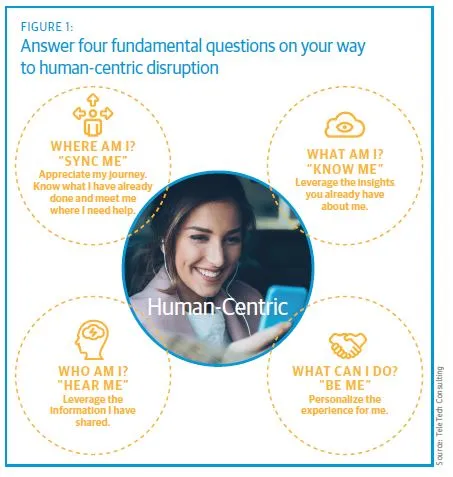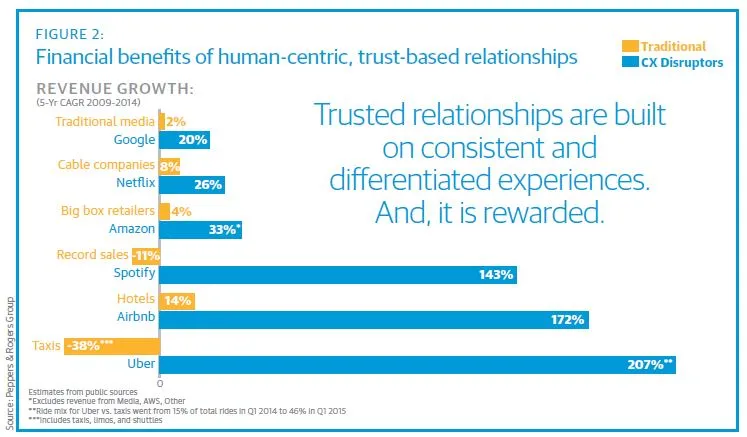Look at nearly any business presentation or conference session about the future of customer experience, and chances are that ridesharing service Uber will be mentioned. It is heralded as an example of a digitally native company that “gets it right” with its customer strategy. It sits alongside Amazon and Apple as experience “North Star” brands for most business leaders.
What about Uber makes it such a symbol of disruption? Anyone who has used it knows there are many reasons. The company was built from scratch around customer needs, not product features. In fact, the platform is the product, which works when the customer owns the interaction from start to finish. There are no manuals or rules to follow. The process is simple and controlled by the customer. The driver and car are merely conduits to serve customer needs.
The company is nimble. Its platform is mobile-only. It provides services in real time. These are what customers demand from brands they do business with. Live traffic and GPS tracking give customers the exact information they need about who will pick them up, when they will arrive, and even the route they will take. The company fits in your pocket and is accessible at any time. In addition, continuous customer and driver feedback informs improvements, like its personalized app designed around the question, “Where to,” or gift cards available for purchase. The company is flexible enough to scale and adapt more quickly than traditional companies, based on insight generated through its app.
Uber is built around community and social aspects, which lead to authenticity and transparency. User reviews, referrals, and recommendations help the company grow through collaboration with its customers. All interactions are meant to not only create a good experience, but also serve as part of its learning relationship with customers.
And finally, employee engagement and empowerment are themselves features of Uber’s value proposition. Drivers own and operate their own cars, leading some to compete to provide the best experience for riders. Some have special lights and music, offer food and drinks, or other incentives to encourage good reviews and repeat business. The experience they deliver is, in fact, Uber’s main business offering.
All of these attributes lead to a simple conclusion—at their core, brands like Uber treat their customers and employees like humans first. Revenue and growth naturally follow.
Four steps to human-centric thinking
Many companies wish they could do the same for their customers. Too often, however, they are limited by legacy systems, process, or cultural barriers. A typical excuse is that because they’re not a digital brand built from scratch, traditional companies can’t possibly compete. Or they’re too afraid to empower their customers to control the interactions. That is the wrong thinking. Companies in any industry, with any set of customers, can make improvements to their own customer experiences by disrupting themselves with an Uber-like, human-centered approach.
As humans, we have memories of our interactions with brands, which set expectations for future interactions. Deviation from these expectations is what leads to subpar service experiences. Organizations have memories too, which comes from the data they have about the customer. Successful organizations, both old and new, master the art of synchronizing experiences across all customer interaction points by having their “memory of the customer” serve them.
Here are a few consumer questions to help organizations create customer memories and transform the experience to be more “human-centric” and frictionless (see Figure 1).

Who am I? Effectively and authentically knowing customers as more than just consumers of a product or service builds a bond that strengthens the customer relationship. Successful organizations have developed a discipline of customer preference management to harness preferences and solicit information in a value exchange to get a deeper picture of individual customer behavior, needs, and value. They can then act with more relevance, cater to customer needs, and generate higher revenues. Companies can hold customers captive by adopting the mantra of, “What you say WILL be held to your benefit!”
What am I? Companies know more about customers than just what they share proactively. Combining customer-related data that exists inside the organization can create an even clearer picture of what the customer is looking to do. For example, when a customer reaches out for support to their energy company, customer analytics combined with information on possible outages can provide the associate potential reasons for the call, even before the customer shares it. This information can be leveraged in making routing decisions and getting the customer quickly to an associate who can effectively and quickly address the reason for their call. It results in a great service experience and leads to a quicker handle time, resulting in a win-win situation.
Where am I? Appreciate the customer journey and the unique aspects of each touchpoint on that journey. Create simple and intuitive steps for customers that empower them to resolve issues quickly and without friction. Keep their experience continuous and consistent across different channels. Successful omnichannel initiatives are grounded in this basic principle.
What can I do? Today’s technology-savvy customers demand a personalized experience. Most have tried multiple ways to solve their own issue before reaching out to the support organization. A “your call is important to us” greeting just doesn’t cut it. Meeting them where they need help and personalizing the experience for them to resolve their issue is of most value. Be proactive and relevant in your interactions. Use the data available and the information they have already shared to help personalize their journey and easily help them resolve their issue.
Emotion and engagement: Keys to the connected lifestyle
Delivering a human-centric experience isn’t just a nice thing to do. It can pay high dividends (see Figure 2). As a result, companies are investing in platforms to deliver an emotional and engaging service experience at scale. They are deliberately designing and enabling one common platform both for customers and employees. The design of this platform synchronizes the inside-out view of enabling employee capabilities with an outside-in view for customers to engage with the organization or self-serve. The common platform lends itself to connectivity and collaboration, in essence integrating all parts of the interaction across various channels to deliver a seamless and consistent service experience.

Conclusion
Companies like Uber aren’t successful because of their technology alone. They’re successful because they put the customer first and create human-centered experiences. Sure, there is risk in traditional companies moving away from the status quo. But as firms like Uber, Amazon, and Apple have proven, there is also enormous reward, both financially and for long-term customer relationships.
















